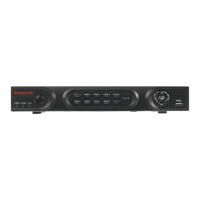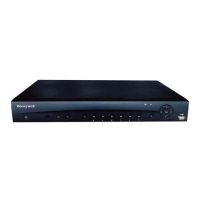
Do you have a question about the Honeywell HRGX162 and is the answer not in the manual?
Provides a summary of the main features and capabilities of the HRGX DVR.
Details the physical layout and components of the HRGX DVR's front panel.
Explains the different connectors and ports available on the HRGX DVR's rear panel.
Describes how to use the mouse for navigating and operating the HRGX DVR interface.
Details the functions and usage of the supplied IR remote control for the DVR.
Lists essential safety and environmental guidelines to follow during DVR installation.
Guides on connecting cameras, monitors, audio, network, and other devices to the DVR.
Provides step-by-step instructions for safely powering the DVR on and off.
Walks through the initial configuration process using the DVR's setup wizard.
Explains the live view mode and its on-screen notifications and quick toolbar.
Customizes live view display, including screen layout and video output modes.
Covers switching channels, output switching, and digital zoom in live view.
Introduces the on-screen interface for controlling PTZ cameras.
Details how to set up communication parameters for PTZ cameras.
Guides on setting up and executing PTZ camera movements and sequences.
Explains manual and automatic recording initiation from the live view interface.
Sets up custom recording schedules for channels based on time and day.
Details how to manually start or stop recording for specific channels.
Sets video stream type, resolution, bitrate, and frame rate for recording.
Guides on how to find and play recorded video for specific camera channels.
Details methods for searching and playing recorded video based on date and time.
Covers creating video clips, working with tags, and using digital zoom during playback.
Instructions for exporting recorded video to external storage devices.
Guides on how to save created video clips to an external storage device.
Sets up sensor inputs and defines alarm response actions for detected events.
Configures dwell time and handling properties for external alarm outputs.
Sets up motion detection areas, sensitivity, and associated alarm responses.
Sets up basic network parameters like IP address, DHCP, and ports.
Configures PPPoE, DDNS, NTP, SNMP, UPnP, and Multicast network features.
Monitors network traffic, tests connectivity, and exports network packets.
Checks the operational status, capacity, and health of installed hard disk drives.
Guides on connecting NAS or SAN devices to expand DVR storage capacity.
Manages multiple HDDs by grouping them and setting properties like R/W or Redundancy.
Customizes on-screen display text, including date, time, and camera names.
Adjusts image parameters like brightness, contrast, and saturation for cameras.
Defines zones on camera feeds to conceal sensitive areas from view.
Sets up system-wide parameters like language, resolution, and date/time.
Displays details about the DVR's hardware, firmware, cameras, and network status.
Provides instructions for updating the DVR's firmware locally or remotely.
Describes the Administrator, Operator, and Guest user account types and permissions.
Guides on creating new Operator or Guest user accounts with specific access levels.
Details how to modify user permissions and account information.











